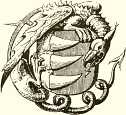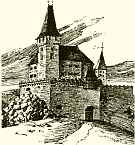 Around 1561 Erzsébet Bathory was born into one of the noblest families of Hungary. Her father was György Bathory of Ecsed. Her mother was Anna Bathory, a sister of Stephan Bathory (1533-1585), King of Poland and Prince of Transylvania.
Erzsébet's cousins Andreas and Zsigmond were Princes of Transylvania, too, and Zsigmond made in 1595 a grand marriage with Princess Maria Christina of Habsburg1.
Around 1561 Erzsébet Bathory was born into one of the noblest families of Hungary. Her father was György Bathory of Ecsed. Her mother was Anna Bathory, a sister of Stephan Bathory (1533-1585), King of Poland and Prince of Transylvania.
Erzsébet's cousins Andreas and Zsigmond were Princes of Transylvania, too, and Zsigmond made in 1595 a grand marriage with Princess Maria Christina of Habsburg1.
As a girl, Erzsébet lived with her family in Nagy-Ecsed near the Romanian border. She had a cruel elder brother and two surviving sisters2. In 1566 the German Emperor made a temporary truce with the Ottoman Turks, so Erzsébet must have grown up in a relatively peaceful environment. She learned to read and write in Hungarian, Greek, Latin and German. In 1570 she was officially engaged to the wealthy Count Ferencz Nadasdy de Nadasd of Fogarasfold (1555-1604), who later became known as the "Black Bey". She was sent to castle Sárvár to live with her mother-in-law, who died the next year. Erzsébet was already a voluptuous, ravishing beauty with long hair and an exquisite complexion. Rumours said that Erzsébet became pregnant in 1574 and gave birth to an illegitimate daughter. The baby is supposed to have been smuggled away.
On May 8, 1575, Erzsébet was married to Ferenc Nadasdy (below right) and the wedding celebrations continued for weeks. The Count was probably born around 1550 and had been trained at the Imperial Court in Vienna. He was usually away on various military campaigns against the Turks, leaving Erzsébet mistress of the gloomy castle of Csejthe atop a barren mountain in the Carpathians. In his absence Erzsébet amused herself with fashionable sex toys imported from Italy and she bleached her hair in the Venetian fashion. She also started experimenting with herbal brews, potions, powders and drugs.
 Erzsébet had an inflammable temper. Servants were severely punished and beaten mercilessly upon making the slightest mistake. Sometimes they were whipped until they bled and then trashed with stinging nettles. Erzsébet used branding irons, razors, pincers and torches.
She sewed the mouth closed of a girl that chattered too much. One day, when Ferenc returned home, he found a naked girl, smeared with honey, bound to a tree.
When Erzsébet suspected a servant of stealing money, she would make her undress and burn her body with heated coins.
Three trusted female servants and a retarded manservant helped Erzsébet punishing the other servants.
One of them, Darvulia3, taught the Countess some new cruelties.
Erzsébet may also have been inspired by her aunt Klara4, a sadomasochistic bisexual, who liked flagellation. Ferenc Nadasdy will probably have learned Erzsébet some tricks, too, because mutilations were commonplace in the skirmishes with the Turks.
Erzsébet had an inflammable temper. Servants were severely punished and beaten mercilessly upon making the slightest mistake. Sometimes they were whipped until they bled and then trashed with stinging nettles. Erzsébet used branding irons, razors, pincers and torches.
She sewed the mouth closed of a girl that chattered too much. One day, when Ferenc returned home, he found a naked girl, smeared with honey, bound to a tree.
When Erzsébet suspected a servant of stealing money, she would make her undress and burn her body with heated coins.
Three trusted female servants and a retarded manservant helped Erzsébet punishing the other servants.
One of them, Darvulia3, taught the Countess some new cruelties.
Erzsébet may also have been inspired by her aunt Klara4, a sadomasochistic bisexual, who liked flagellation. Ferenc Nadasdy will probably have learned Erzsébet some tricks, too, because mutilations were commonplace in the skirmishes with the Turks.
For more than 10 years the Nadasdy couple remained childless, but around 1585 Erzsébet gave birth to Anna. Orsolya, Katalin and two sons, András and Pal, followed. Orsolya and András both died young. Sometimes Erzsébet accompanied her husband to Bratislava or Vienna. In March 1601 Ferenc Nadasdy suffered from excruciating pains in his legs, but he recovered. He was ill again by the end of 1603. When he died at castle Sárvár on January 4, 1604, Erzsébet took over the management of their estates. Her brother, who had lived for years in seclusion, died the next year. That same year Erzsébet married her eldest daughter to Count Miklós Zrinyi, a cousin of Count György Thurzó (±1565-1616), one of the mightiest men in Hungary.
 Although Erzsébet was now in a vulnerable position as a rich widow with a son under age, she still had powerful friends. Count Thurzó, for example, invited her for a wedding in 1607. In 1608 Erzsébet's second cousin, Anna Bathory, who had been raised by Erzsébet's brother at Ecsed, married. That same year
Although Erzsébet was now in a vulnerable position as a rich widow with a son under age, she still had powerful friends. Count Thurzó, for example, invited her for a wedding in 1607. In 1608 Erzsébet's second cousin, Anna Bathory, who had been raised by Erzsébet's brother at Ecsed, married. That same year Her 40th birthday must have been annoying to a beautiful and vain woman like Erzsébet. According to folklore, Erzsébet became obsessed with the idea to remain young and beautiful forever. One day, in an outburst of temper, Erzsébet was said to have struck a servant girl across the face with such a powerful blow that her nose bled. Some blood spat on Erzsébet's skin and she thought that it made her skin look younger and fresher. Thus she supposedly got the idea to bath in the blood of virgins. When Erzsébet wanted to take a bath, a girl was fetched and held upside down over the tub, while her throat was slashed. After some years Erzsébet apparently concluded that the blood of peasant virgins was not good enough and that she thus needed the blue blood of noble virgins. This part of the story, however, is pure speculation.
Whatever Erzsébet's motives may have been, from 1600 onwards the death rate among her servants increased. She acquired the help of her trusted servants to recruit new girls. For small sums of money poverty-stricken fathers of young peasant girls were persuaded to send their daughters off to "a life of security in the service of the mighty House of Bathory". Often they were bound
In 1609 Erzsébet started taking in aristocratic girls "to teach them social graces", but some of them died, too, and rumours about atrocities at castle Csejthe became stronger. In October 1610 Erzsébet took her daughter Anna, Countess Zrinyi, to Piestány for a bath in the warm mud. Afterwards she travelled to castle Sárvár, where her young son was living with his tutor. She took her jewels and other values with her, when she returned to Csejthe. Meanwhile, a priest of a nearby village notified the already alarmed authorities of his suspicions. On December 10, Erzsébet and her accomplices were arrested by Count Thurzó. The trial started in January 1611 and, because of Erzsébet's rank, it was held in secret and the Countess never attended it. Around that time in the Balkans servants were serfs and thus Erzsébet had the right to do with them whatever she fancied. That's why the emphasis of the trial lay on what she had done to girls of noble birth.
 While Erzsébet's accomplices were tortured, they described 36 to 50 deaths as a result of mistreatment. Then additional witnesses were heard. One mentioned 80 death girls, another 175 and later the figure raised to 200. Some witness accounts were purely based on hearsay. The Countess was said to have kept notes in a diary, listing 650 girls she had tortured and slain, but the list was never shown in court. Witnesses mentioned
While Erzsébet's accomplices were tortured, they described 36 to 50 deaths as a result of mistreatment. Then additional witnesses were heard. One mentioned 80 death girls, another 175 and later the figure raised to 200. Some witness accounts were purely based on hearsay. The Countess was said to have kept notes in a diary, listing 650 girls she had tortured and slain, but the list was never shown in court. Witnesses mentioned All of the accused were found guilty as charged. The notorious Darvulia had become blind and died before the start of the trial, but the two other female accomplishes had their fingers torn from their hands by red-hot pincers before they were burned at the stake as witches. Erzsébet was walled up alive in a small tower room. Slits were left for air
Some years after Erzsébet's trial, the widowed Anna Bathory, Erzsébet's second cousin, was brought to trial by the new Prince of Transylvania, Gábor Bethlen, on the accusation of "witchcraft" and "incest with her late brother Gábor". She was stripped of
Rich widows were an easy prey for powerful men. Therefore, a theory has been put forward that Erzsébet may have been brought to trial to avoid a far worse trial for treason, because of her involvement with her second cousin, Gábor Bathory. It could have resulted in a confiscation of her properties by the Emperor, while her son, her uncle-in-law and Count Thurzó preferred to share Erzsébet's rich inheritance among themselves. With evidence that is partly based on hearsay and partly extracted from accomplishes under torture, it is impossible to determine if Erzsébet intentionally murdered hundreds of girls or that accidentally some of her servants died as a result of her brutal punishments. There is, however, no doubt that Erzsébet Bathory cruelly mistreated her servants.